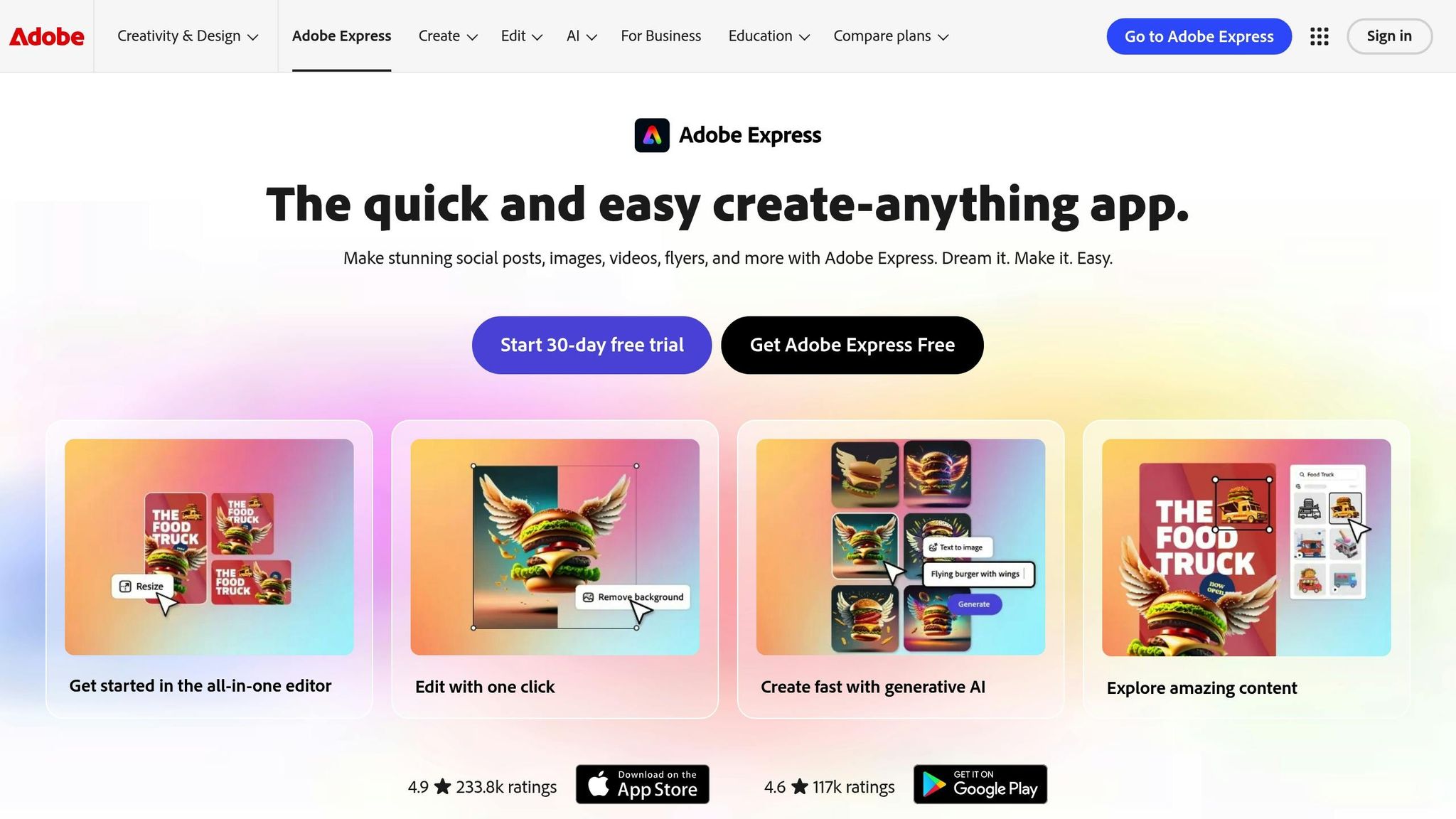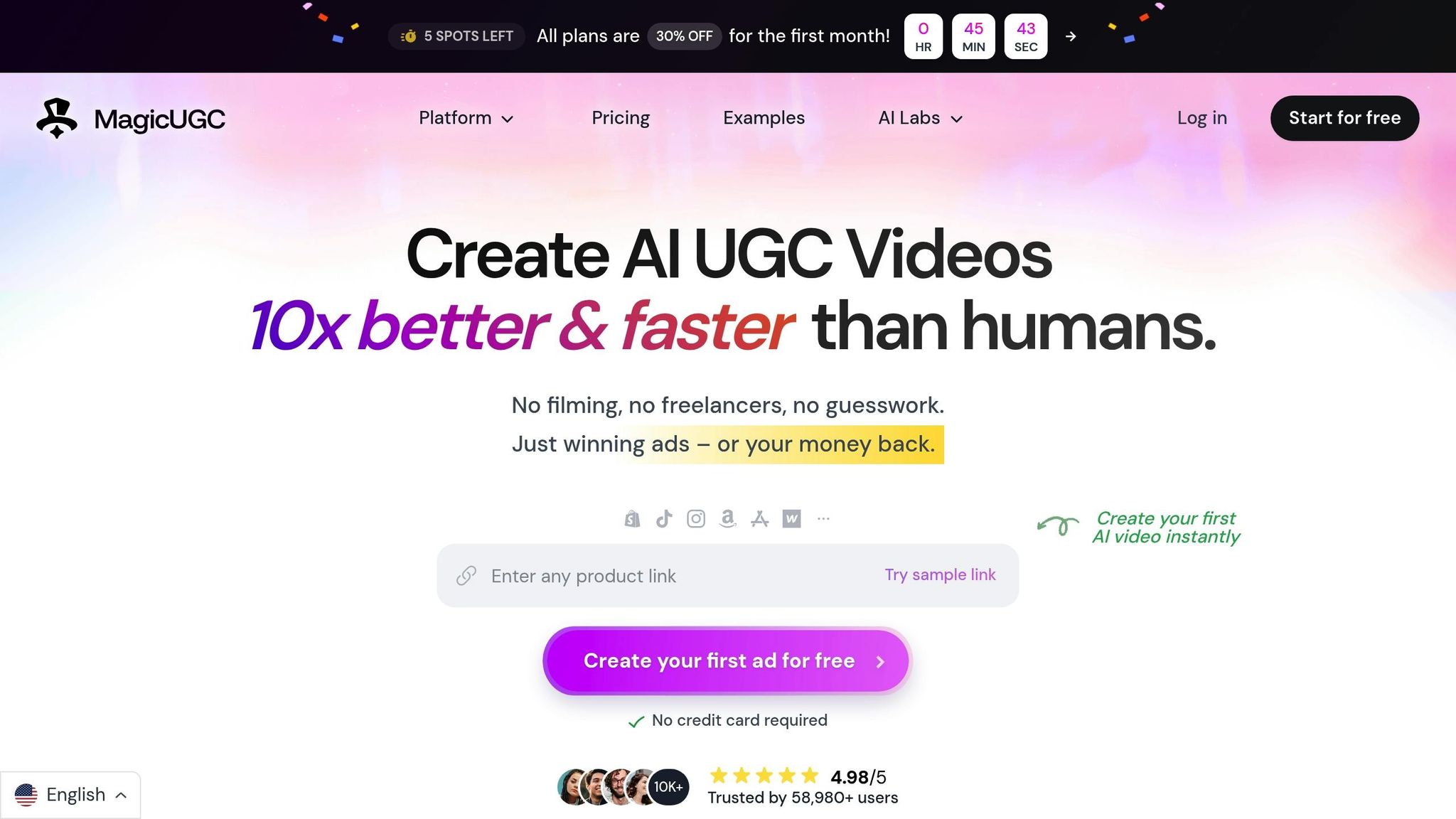
Batch video iteration is the process of creating multiple video variations quickly by using templates, automation, and data-driven tools. This method helps businesses produce scalable, targeted video content for social media, personalized campaigns, and large-scale strategies. Instead of starting from scratch for every video, batch iteration streamlines production by reusing elements like text, images, and audio, making it faster and more efficient.
Key Takeaways:
- What It Is: A method to produce multiple video variations efficiently using templates and automation.
- Why It’s Useful: Saves time, reduces costs, and improves marketing flexibility.
- Core Benefits:
- Time and budget savings by creating content in bulk.
- Easier personalization for different platforms and audiences.
- Continuous testing and improvement to optimize performance.
- Tools to Use: AI platforms like MagicUGC automate production, scriptwriting, and audience targeting, enabling businesses to scale content effectively.
Batch video iteration is ideal for businesses aiming to stay competitive in fast-paced digital markets. By combining structured workflows, AI tools, and data insights, companies can produce high-quality videos at scale while maintaining brand consistency and engaging audiences effectively.
Saving Time with Batch Content Creation | Adobe Express

Setting Up Your Batch Video Iteration Workflow
To make the most of batch video iteration, you need a well-organized workflow that ensures consistency and scalability. A clear plan is essential to achieve measurable results.
Defining Your Content Goals and Audience
Every successful video workflow begins with clearly defined objectives and a deep understanding of your audience.
Setting SMART Goals for Video Content
Start by creating goals that are Specific, Measurable, Achievable, Relevant, and Time-bound (SMART). For example, aim for something like: "10,000 video views and 500 email subscribers in 30 days via Instagram Reels". This structured approach is backed by data: 74% of marketers say videos provide better ROI than static images, and nearly 93% of brands have gained new customers through social media videos.
Understanding Your Target Audience
Use tools like customer surveys, social listening, and analytics to gather insights about your audience. Develop detailed buyer personas to tailor your videos for specific segments. This strategy works - 66% of people prefer short videos to learn about products or services. A great example is Old Spice, which shifted its branding in 2010 after discovering that women were the primary purchasers of their products. This insight led to a complete transformation of their marketing efforts.
Aligning Content Types with Marketing Objectives
Plan your content around key themes, campaigns, or seasonal opportunities. Match video formats with specific goals: educational videos build trust, behind-the-scenes clips humanize your brand, and product demos drive sales. Each platform has unique requirements, so tailor your content to fit audience behaviors on Instagram, TikTok, YouTube, or LinkedIn.
Once your goals and audience are defined, you can incorporate AI tools to streamline production.
Using AI-Powered Tools Like MagicUGC

AI tools like MagicUGC can transform how businesses handle batch video production, enabling high-quality content creation without the need for traditional filming.
Automating Core Production Tasks
MagicUGC simplifies video production through AI automation. It handles scriptwriting, ensures brand consistency, and creates multiple video iterations using AI models trained on over a million successful Instagram and TikTok videos. This ensures your content follows proven engagement strategies.
As Tamika Carlton, Author, puts it:
"AI acts as a creative partner. From automating repetitive tasks to unlocking innovative possibilities, it creates a new way for teams to approach video production."
Key Features for Batch Production
MagicUGC offers tools that make batch production more efficient for U.S. businesses. Features include:
- AI Persona Targeting: Create variations of videos for different demographic groups.
- Cultural Adaptation: Ensure content resonates with diverse U.S. audiences.
- AI Script Optimization: Refine messaging based on performance data.
- Demographic Customization: Tailor content for various age groups and interests.
Its Boost™ feature has even increased conversion rates by 275%, proving its value for scaling video marketing efforts.
Real-World Impact on Production Efficiency
By eliminating the need for traditional filming, freelancers, or manual editing, AI-powered workflows save time and money. MagicUGC maintains the authentic feel of user-generated content, which performs exceptionally well on social media platforms.
Creating a Content Calendar
A content calendar is the backbone of your batch video iteration workflow, ensuring consistent output and alignment with your goals.
Establishing Your Publishing Framework
Decide on your content objectives, whether it’s increasing brand awareness, generating leads, educating customers, or showcasing products. Pick a publishing frequency - weekly, bi-weekly, or monthly - and stick to it. As LianaTech.com explains:
"A content calendar is an effective tool for coordinating content creation that helps to divide your team's upcoming workload into clear, easily manageable units. By implementing this tool into your planning process, you will spend less time wondering what to write and instead focus on the creation itself."
Use digital tools to organize tasks and deadlines. Your calendar should include publishing dates, assigned team members, deadlines, platform details, and performance tracking notes.
Strategic Content Planning
Keep your audience engaged by mixing evergreen and timely content. Consider formats like FAQs, day-in-the-life videos, customer success stories, seasonal campaigns, how-to guides, and product teasers. Tailor content to specific platforms: short-form videos for Instagram and TikTok, long-form educational videos for YouTube, professional insights for LinkedIn, and community-focused content for Facebook.
Batch Production Integration
Dedicate specific days for filming multiple videos, then edit and schedule them in batches. This approach not only aligns with batch video iteration principles but also ensures consistency in production and maximizes creative energy.
A well-structured content calendar paired with batch production techniques sets the stage for efficient, scalable video marketing. By organizing your workflow and leveraging AI tools, you'll be better equipped to meet your goals and optimize your strategy over time.
Step-by-Step Guide to Batch Video Iteration
Once your workflow is in place, it’s time to put your batch video iteration strategy into action. This method ensures you can churn out multiple high-quality videos while keeping your content consistent and on-brand.
Ideation and Script Creation
The ideation phase sets the foundation for your entire production process. Start by reviewing your content calendar to pinpoint themes that align with your marketing goals and resonate with your audience.
Brainstorming Ideas for U.S. Audiences
Focus on topics that connect with American consumers and their interests. Tap into seasonal events like Black Friday, the Super Bowl, or back-to-school shopping - these moments naturally drive engagement. To stay current, explore trending hashtags on Instagram and TikTok to see what’s sparking conversations within your target demographic. Then, adapt popular ideas to fit your brand’s perspective.
Organize your ideas into content categories to keep things interesting. For example:
- Tutorials that educate your audience
- Behind-the-scenes peeks into your brand
- Customer testimonials that build trust
- Product demos showcasing features
- Fun challenges tied to current trends
Using AI to Speed Up Scriptwriting
Platforms like MagicUGC can simplify your scriptwriting process. Its AI, trained on over a million successful Instagram and TikTok videos, identifies patterns that drive engagement. With its Script Optimization tool, you can create scripts tailored to your brand voice while incorporating elements that boost virality.
Testing Script Variations
To find what resonates most with your audience, draft multiple versions of a script around the same core message. Experiment with different tones, benefits, and calls-to-action. MagicUGC’s Persona Targeting feature takes this a step further by customizing scripts for specific demographics. For instance, one version might cater to urban millennials, while another speaks directly to suburban Gen Xers - all while staying true to your brand identity.
Once your scripts are finalized, you’re ready to move into asset collection and production.
Asset Collection and Video Production
Gathering and organizing your assets is key to creating consistent, polished video content.
Building a Centralized Asset Library
Create a well-organized library of essential materials like logos, color palettes, fonts, product images, background music, and sound effects. Sort these assets by campaign, product line, or content theme to make them easy to locate. Also, prepare assets in multiple dimensions to meet the technical requirements of platforms like Instagram, TikTok, and YouTube.
Sticking to Brand Guidelines
Consistency is crucial for building a recognizable brand. Document clear guidelines for visuals and audio, including color schemes, typography, logo placement, and tone of voice. Tools like MagicUGC can help enforce these standards automatically, ensuring every video aligns with your brand without the need for constant manual adjustments.
Simplifying Asset Integration
Use cloud-based storage to give your team easy access to assets, no matter where they’re working. Tag files with relevant keywords for faster searching, and develop templates for common video formats - such as product launches or testimonials. This approach ensures a smooth workflow as you produce multiple iterations.
Automation with AI Tools
With your workflow and content calendar established, automation can take your production process to the next level.
AI-Powered Video Creation and Editing
MagicUGC’s AI can handle tasks like scene transitions, text overlays, and audio syncing, allowing you to produce dozens of video variations in the time it would normally take to create just a few. By automating these steps, you can focus more on creativity and strategy.
Adapting Content for Diverse Audiences
For businesses targeting a wide range of U.S. consumers, MagicUGC’s multi-language support is a game-changer. Beyond simple translation, the platform adapts cultural references, visuals, and messaging to resonate with different ethnic and linguistic groups. This is especially useful in diverse cities like Los Angeles, New York, and Miami, where multilingual marketing can significantly boost engagement.
Data-Driven Content Iteration
MagicUGC’s predictive scoring feature evaluates your video concepts based on factors like script quality, visual elements, and timing. This helps you prioritize the most promising variations before full production. Early adopters of MagicUGC Boost™ have reported a 275% increase in conversion rates, showing how effective this data-driven approach can be in creating high-performing content.
Effortless Publishing and Scheduling
Automation doesn’t end with production - it extends to publishing too. Set up workflows to format videos for different platforms, apply platform-specific captions, and schedule posts at optimal times. MagicUGC even offers 24/7 content generation, ensuring your brand stays active and visible without requiring constant oversight. This seamless process keeps your audience engaged while saving you valuable time.
sbb-itb-d822133
Optimizing and Scaling Your Batch Video Iterations
Once your production process is running smoothly, the next step is to turn your data into actionable insights and expand your campaigns beyond the initial stages.
Performance Analytics and Feedback Loops
To understand which videos are delivering results, you need to track meaningful metrics and set up systems that transform data into better content strategies.
Focus on Metrics That Drive Revenue
While views and likes are nice to have, they don’t always tell the full story. Instead, focus on metrics like conversion rate, which shows how many viewers take action after watching your video. Keep an eye on cost per acquisition (CPA) to understand how much it costs to gain a new customer. Another key metric is return on ad spend (ROAS), which measures the revenue generated by your campaigns. For most U.S. businesses, a ROAS of 4:1 is solid, with 3:1 to 4:1 often being the sweet spot.
Watch Engagement Patterns
Metrics like watch time and audience retention can reveal when viewers lose interest. For instance, if your audience consistently drops off early in the video, it might mean your opening hook needs work. On platforms like YouTube, an engagement rate between 2% and 5% is considered good.
Set Up Feedback Systems
Automated reports and centralized dashboards can help you track key metrics across platforms. This setup makes it easier to spot trends and quickly adjust your strategies when something isn’t working. These insights feed directly into iterative testing, creating a cycle of continuous improvement.
Split-Testing and Continuous Improvement
Once you’ve analyzed your data, the next step is to refine your content through systematic testing.
Test High-Impact Elements First
Start by focusing on the elements that can make the biggest difference. Strong video hooks grab attention right away, eye-catching thumbnails boost click-through rates, and clear calls-to-action encourage viewers to take the next step. For example, in January 2025, Nextiny Marketing reported a 25x increase in a client’s conversion rate after swapping out a long homepage video for a shorter, more focused version.
Run A/B Tests Methodically
When testing, change only one element at a time to isolate its impact. Make sure to run your tests for at least a week and gather enough data to account for daily fluctuations.
Apply Learnings Across Your Content
Once you find what works - whether it’s a specific type of hook, thumbnail, or call-to-action - apply those insights to your content templates. This ensures every new batch of videos benefits from what you’ve already learned.
Scaling with MagicUGC's Advanced Features
With insights in hand, you can scale your video efforts using advanced AI tools like MagicUGC. These tools help you maintain quality while increasing output.
Maintain Consistency with the Brand DNA Scanner
MagicUGC’s Brand DNA Scanner analyzes your existing content to identify your unique voice and visual style. This ensures all new videos align with your brand’s tone and aesthetic.
Generate Content Around the Clock
The platform’s 24/7 content generation capabilities allow your brand to stay active at all times. This feature highlights the platform’s ability to produce high-performing content at a larger scale.
Use Data to Optimize Content
MagicUGC’s AI evaluates performance data from over one million top-performing Instagram and TikTok videos. It predicts which content variations are most likely to succeed, helping you prioritize your resources on ideas with the highest potential.
Reach Diverse Audiences
For businesses targeting different demographics across the U.S., MagicUGC’s multi-language support and localized features let you tailor content to resonate with specific communities. Whether you’re focusing on California, Texas, or Florida, customizing visuals, messaging, and references can help you connect with diverse audiences.
Best Practices for Batch Video Iteration
Once you've optimized your workflow and scaled your operations, the next hurdle is ensuring your videos maintain quality and consistency. It's also important to sidestep common challenges that could disrupt your production process.
Maintaining Brand Consistency
Consistency is key to reinforcing your brand identity. It fosters trust, keeps your audience engaged, and ensures your brand stays recognizable. Without clear guidelines, batch production can lead to videos that feel disconnected from your core message.
-
Develop Clear Brand Guidelines
Lay down specific rules for how your videos should look and feel. This includes details like logo placement, color schemes, typography, tone, branded intros and outros, and consistent color grading. A well-documented style guide ensures every video reflects your brand's personality, whether that's professional, playful, or somewhere in between. -
Use Templates to Standardize Production
Incorporate motion graphics, text overlays, and a uniform editing style. This helps create a consistent rhythm across videos. Also, ensure your calls to action follow the same language and placement in each video. -
Leverage Automation Tools
Automation tools can help enforce your brand guidelines, reducing the need for constant manual checks. AI-driven tools, for instance, can analyze your videos to ensure they align with your established style. -
Streamline Team Collaboration
Shared templates for elements like intros, outros, and lower thirds can keep everyone aligned. Pair these with project management tools to ensure smooth coordination among team members. This reduces inconsistencies and supports a scalable production model.
Once your brand foundation is solid, the next step is keeping your content fresh to avoid losing your audience's interest.
Avoiding Content Fatigue
Producing similar videos repeatedly can lead to content fatigue, where your audience starts to tune out. To keep engagement high, variety is essential.
-
Switch Up Creative Elements
Refresh your visuals, copy, and calls to action regularly. Experiment with different video lengths, formats, and angles to keep things interesting. -
Explore Different Content Formats
Don’t stick to one type of video. Try interactive ads, immersive experiences, or mobile-friendly formats to grab attention in new ways. -
Track Key Metrics
Keep an eye on metrics like click-through rates, engagement, and conversions. A noticeable drop could indicate content fatigue, signaling it's time to shake things up. -
Personalize Content for Specific Audiences
Tailor your messaging based on audience preferences, behaviors, and demographics. Customizing your content ensures relevance and prevents overexposure to the same creative.
While keeping your content fresh is vital, ensuring your production process runs smoothly is equally important.
Fixing Common Workflow Problems
Batch video production often encounters predictable issues that can disrupt the entire process. Addressing these challenges early can save time and resources.
-
Ensure Data Quality and Accuracy
A single corrupted file or incorrect input can derail your workflow. Implement data validation checks to catch errors before they escalate. -
Manage Dependencies and Scheduling
Batch systems rely on precise scheduling to function smoothly. Use workflow management tools to define tasks, monitor dependencies, and prevent bottlenecks during production. -
Create Fault-Tolerant Systems
Design your workflow to recover automatically from errors. For instance, if one video iteration fails, it shouldn’t halt the entire production process. -
Optimize for Large Batches
Use strategies like data partitioning and parallel processing to handle large batches efficiently. Adjust batch sizes to match your system's capacity to avoid overloading it. -
Simplify Configuration Management
Complex configurations can slow down production. Invest in user-friendly tools and provide thorough training to your team. Regularly review performance to identify and fix bottlenecks.
MagicUGC’s automated systems tackle many of these workflow challenges by offering features like built-in error handling, automated quality checks, and scalable processing that adjusts to your production needs. This ensures smoother operations and fewer disruptions.
Conclusion and Main Takeaways
Batch video iteration is a game-changer for scaling content production while maintaining quality and consistency, from the initial setup to advanced techniques.
Why Batch Video Iteration Works
Batch video iteration can dramatically improve marketing ROI. Consider this: 93% of marketers report positive ROI from video marketing. Traditional video production costs range between $1,000 and $5,000 per minute, but AI video tools have slashed that to $500-$3,000 per minute - reducing costs by as much as 60-80%.
Production speed is another major win. Companies using AI tools can cut production times by up to 50%, with some tools reducing traditional timelines by an impressive 90%. This efficiency means brands can produce over 100 video variants in a single batch, leading to engagement boosts of up to 35%. Plus, maintaining a consistent posting schedule through batch iteration results in five times more engagement compared to irregular posting.
With these advantages, adopting batch video iteration is a practical, high-impact strategy for modern marketers.
How to Get Started Today
To make the most of batch video iteration, start by aligning your video strategy with clear business goals. Are you aiming to increase brand visibility, drive conversions, or build community engagement? Define your objectives first.
Understand Your Audience. Build detailed buyer personas to ensure your videos connect with the right people. Keep in mind that videos under two minutes tend to perform best, with 73% of marketers agreeing this is the sweet spot for engagement.
Use AI Tools Like MagicUGC. Tools like MagicUGC simplify the process with features such as AI-driven script generation, multi-language support, and automatic video iterations. Trained on over 1 million high-performing Instagram and TikTok videos, MagicUGC helps overcome common hurdles like tight budgets and limited time.
"The biggest mistake people make is they try to do too much too soon. Creating video content yourself is a huge task, especially when you don't have any video production or editing background." - Jade Beason, Creator, Consultant, and Speaker
Start small. Focus on manageable projects that align with your business goals. Plan your topics and scripts ahead of time, then batch-produce multiple videos in one focused session.
Track and Adjust. Keep an eye on performance metrics like engagement rates, click-through rates, and conversions. Use this data to refine your approach and improve results over time.
With 96% of marketers identifying video as a key part of their overall strategy, embracing batch video iteration is a smart way to stay ahead.
"Instead of focusing on making a perfect ad, focus on making ads that can be optimized over time. No ad will last forever, and creative fatigue is real, so brands that embrace a testing mindset will always have an advantage." - Brett Wagner, Founder, Batch Creative
FAQs
How can businesses create consistent, on-brand videos while appealing to different audience segments?
To keep your brand consistent across multiple video batches, it's essential to set up clear branding guidelines. These should cover standardized elements like your logo, color palette, fonts, as well as intros and outros. By sticking to these, you ensure that every video reflects your brand identity, even if you're tailoring content for different audiences.
Using tools like AI-powered video platforms can make this process smoother. These tools can handle repetitive tasks while staying true to your brand's style. On top of that, regularly analyzing performance metrics and conducting audience tests can help you refine your content for various groups without losing your brand's voice or message.
What challenges might arise when setting up a batch video iteration workflow, and how can you address them?
Setting up a batch video iteration workflow isn’t always straightforward. You might run into hurdles like complicated setup procedures, trouble scaling effectively, strict scheduling requirements, and handling massive amounts of video data.
To tackle these challenges, lean on automation tools to handle repetitive tasks and reduce manual effort. Focus on optimizing workflows for smoother operations, and invest time in careful planning and testing. These strategies can help you build a more efficient and scalable system for managing your video projects.
How does MagicUGC make batch video iteration faster and more cost-effective than traditional video production?
MagicUGC takes the hassle out of creating multiple videos by using AI to produce high-quality content quickly and efficiently. Forget the old-school approach of filming, hiring freelancers, and spending hours on manual edits. With tools like AI-driven script generation and video models trained on over 1 million top-performing TikTok and Instagram videos, MagicUGC automates the entire process. The result? Professional, social media-ready videos tailored to your needs - delivered faster and at a fraction of the cost.



